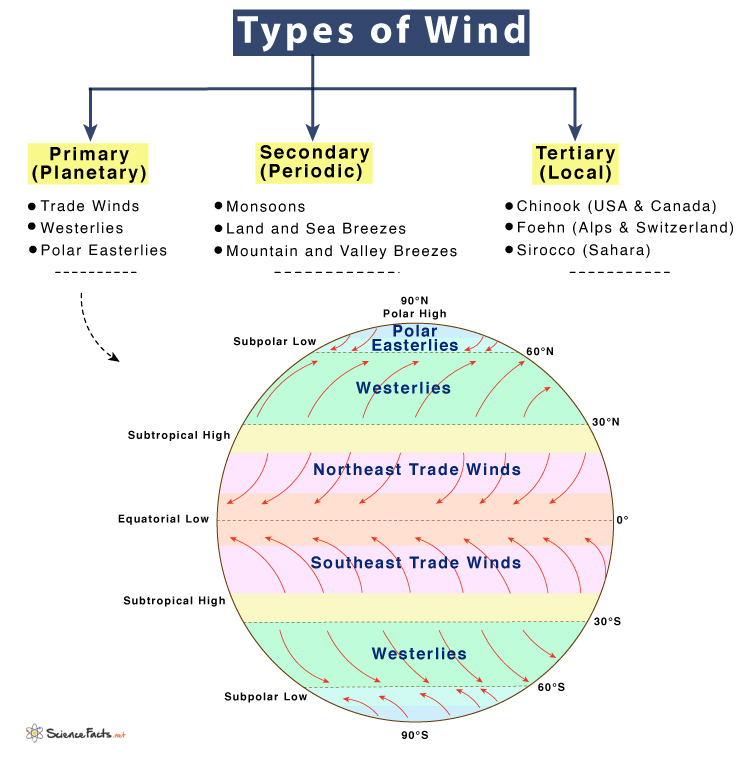1. Primary or Planetary Winds
2. Secondary or Periodic Winds
3. Tertiary or Local Winds
Trade Winds
These are highly steady winds blowing consistently through the sub-tropical high-pressure areas (30°N and S) towards the equatorial low-pressure belt. Trade winds are thus also known as tropical easterlies. Usually, trade winds should blow from the north to south in Northern Hemisphere and south to the north in Southern Hemisphere. However, due to deflection by Coriolis Effect and Ferrel’s law, they deflect to the right side in Northern Hemisphere and to the left side in Southern Hemisphere. Thus, trade winds blow as northeastern trades in Northern Hemisphere and southeastern trades in Southern Hemisphere.
Westerlies
These winds blow from subtropical high-pressure belts towards sub-polar low-pressure belts. Westerlies of the Southern Hemisphere are stronger and fixed in direction than Northern Hemisphere. These winds develop within 40° and 65 °S latitudes, and these latitudes are known as Roaring Forties, Furious Fifties, and Shrieking Sixties.
Polar Easterlies
These are dry, cold prevailing winds that blow from north-east to south-west direction in Northern Hemisphere and south-east to the north-west in Southern Hemisphere.
Monsoons
Monsoons are seasonal winds that change their direction frequently. They are thus a seasonal modification of the general Planetary Wind System. The summer monsoon is characterized by highly variable weather with frequent drought and heavy rains spells. It is also called the South Westerly Wind. In contrast, the winter monsoon is a gentle drift of air in which winds blow from the northeast and is also known as the North Easterly Wind.
Land and Sea Breezes
During the night, landmasses cool quicker than the sea due to radiation, causing high pressure to develop over the land and low pressure over the sea. The pressure difference causes the air from land to move towards the sea, which is termed land breeze. On the contrary, the land is hotter during the day than the sea. The land thus develops low air pressure, and the sea, being cooler, develops high pressure. Thus, the air over land rises and gets replaced by a cool wind called the sea breeze.
Mountain and Valley Breezes
These winds are similar to land and sea breezes. During the day, the slopes of mountains are hot compared to the valleys, and thus air from valleys rushes up the slopes. This breeze is called the valley breeze. After sunset, the pattern gets reversed, and cold air moves from mountains down the slopes towards valleys. This breeze is called the mountain breeze. These winds can be hot, cold, ice-filled, or dust–rich depending on the location, landscape, time, and temperature. Chinook in the USA and Canada, Mistral in France, Foehn in the Alps and Switzerland, Nor’wester in New Zealand, and Sirocco in the Sahara Desert are tertiary winds.
